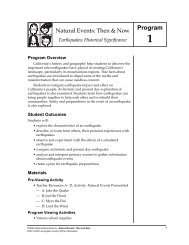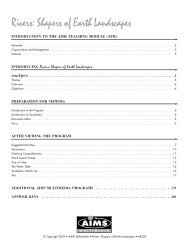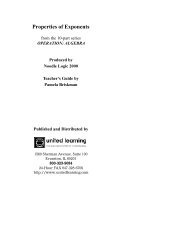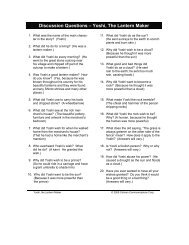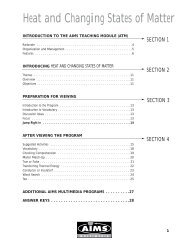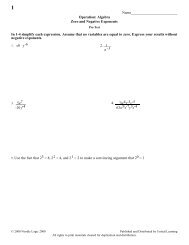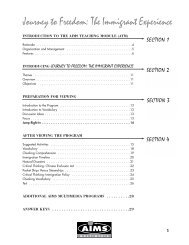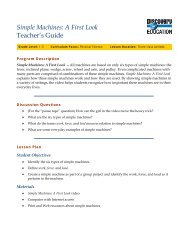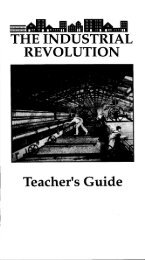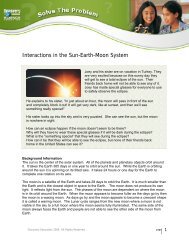Sound Waves - Discovery Education
Sound Waves - Discovery Education
Sound Waves - Discovery Education
You also want an ePaper? Increase the reach of your titles
YUMPU automatically turns print PDFs into web optimized ePapers that Google loves.
Brief Constructed Response<br />
<strong>Sound</strong> <strong>Waves</strong><br />
Teacher Guide<br />
Unit: <strong>Sound</strong>, Heat, and Light<br />
Topic: <strong>Sound</strong><br />
Concept: <strong>Sound</strong> <strong>Waves</strong><br />
Objectives assessed: The student will be able to demonstrate understanding that:<br />
• <strong>Sound</strong> is energy that travels in the form of waves away from a vibrating object.<br />
• <strong>Sound</strong> waves travel through all three states of matter.<br />
• <strong>Sound</strong> waves cannot travel through a vacuum, which has no matter.<br />
Students will need about 15–20 minutes to complete this brief constructed response.<br />
A scientist puts a bell inside a sealed glass jar. She makes the bell vibrate. Then, she sucks all the<br />
air out of the jar with a vacuum pump. She makes the bell vibrate again. Describe what the scientist<br />
probably heard when she made the bell vibrate each time. Explain your answer.<br />
Sample correct response(s):<br />
At first, the scientist probably heard the ringing of the bell. The vibrations of the bell produced sound<br />
waves, which traveled through the air in the jar, through the jar, and then through the air outside the<br />
jar to the scientist's ears. After the scientist removed the air from the jar, she probably did not hear<br />
the ringing of the bell. She would not be able to hear the ringing of the bell because there was no air<br />
in the jar for the sound waves to travel through.<br />
Note: It is also correct for the student to state that the ringing of the bell was fainter or quieter after<br />
the air was removed, and explain that the sound waves could travel only through the bell and the<br />
glass in the jar before getting to the air outside, so the bell sounded quieter.<br />
Brief Constructed Response: <strong>Sound</strong> <strong>Waves</strong> © 2008 <strong>Discovery</strong> Communications, LLC Page 1 of 2
Brief Constructed Response<br />
<strong>Sound</strong> <strong>Waves</strong><br />
Teacher Guide<br />
Response scoring tool:<br />
Score Content<br />
3 Response includes all of the following: statement that the scientist<br />
would hear the ringing of the bell when there is air in the jar;<br />
statement that the scientist would not hear the ringing of the bell<br />
(or would hear a quieter ringing) when the air is removed from the<br />
jar; and explanation that sound travels through the air in the jar in<br />
the first case but cannot travel through the vacuum in the jar in the<br />
second case.<br />
2 Response includes two of the following: statement that the<br />
scientist would hear the ringing of the bell when there is air in the<br />
jar; statement that the scientist would not hear the ringing of the<br />
bell (or would hear a quieter ringing) when the air is removed from<br />
the jar; and explanation that sound travels through the air in the<br />
jar in the first case but cannot travel through the vacuum in the jar<br />
in the second case.<br />
1 Response includes one of the following: statement that the<br />
scientist would hear the ringing of the bell when there is air in the<br />
jar; statement that the scientist would not hear the ringing of the<br />
bell (or would hear a quieter ringing) when the air is removed from<br />
the jar; and explanation that sound travels through the air in the<br />
jar in the first case but cannot travel through the vacuum in the jar<br />
in the second case.<br />
0 No response, or response not appropriate to the question.<br />
For students who are not demonstrating complete mastery of this concept, the <strong>Discovery</strong><br />
<strong>Education</strong> Science video, reading, and interactive resources found in the Learn and Explore<br />
sections of this concept can be assigned to them as remediation.<br />
Brief Constructed Response: <strong>Sound</strong> <strong>Waves</strong> © 2008 <strong>Discovery</strong> Communications, LLC Page 2 of 2



